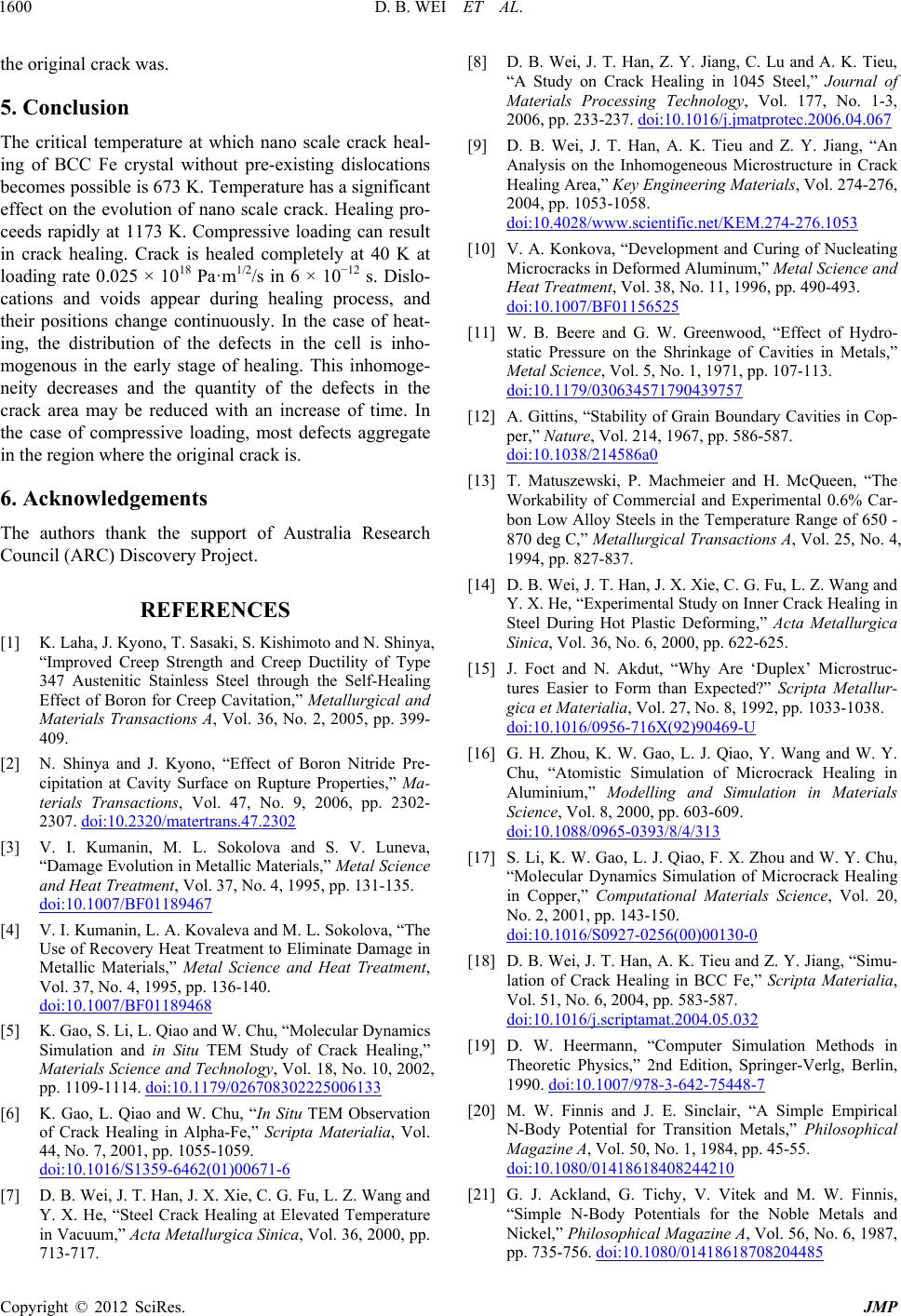
D. B. WEI ET AL.
1600
the original crack was.
5. Conclusion
The critical temperature at which nano scale crack heal-
ing of BCC Fe crystal without pre-existing dislocations
becomes possible is 673 K. Temperature has a significant
effect on the evolution of nano scale crack. Healing pro-
ceeds rapidly at 1173 K. Compressive loading can result
in crack healing. Crack is healed completely at 40 K at
loading rate 0.025 × 1018 Pa·m1/2/s in 6 × 10−12 s. Dislo-
cations and voids appear during healing process, and
their positions change continuously. In the case of heat-
ing, the distribution of the defects in the cell is inho-
mogenous in the early stage of healing. This inhomoge-
neity decreases and the quantity of the defects in the
crack area may be reduced with an increase of time. In
the case of compressive loading, most defects aggregate
in the region where the original crack is.
6. Acknowledgements
The authors thank the support of Australia Research
Council (ARC) Discovery Project.
REFERENCES
[1] K. Laha, J. Kyono, T. Sasaki, S. Kishimoto and N. Shinya,
“Improved Creep Strength and Creep Ductility of Type
347 Austenitic Stainless Steel through the Self-Healing
Effect of Boron for Creep Cavitation,” Metallurgical and
Materials Transactions A, Vol. 36, No. 2, 2005, pp. 399-
409.
[2] N. Shinya and J. Kyono, “Effect of Boron Nitride Pre-
cipitation at Cavity Surface on Rupture Properties,” Ma-
terials Transactions, Vol. 47, No. 9, 2006, pp. 2302-
2307. doi:10.2320/matertrans.47.2302
[3] V. I. Kumanin, M. L. Sokolova and S. V. Luneva,
“Damage Evolution in Metallic Materials,” Metal Science
and Heat Treatment, Vol. 37, No. 4, 1995, pp. 131-135.
doi:10.1007/BF01189467
[4] V. I. Kumanin, L. A. Kovaleva and M. L. Sokolova, “The
Use of Recovery Heat Treatment to Eliminate Damage in
Metallic Materials,” Metal Science and Heat Treatment,
Vol. 37, No. 4, 1995, pp. 136-140.
doi:10.1007/BF01189468
[5] K. Gao, S. Li, L. Qiao and W. Chu, “Molecular Dynamics
Simulation and in Situ TEM Study of Crack Healing,”
Materials Science and Technology, Vol. 18, No. 10, 2002,
pp. 1109-1114. doi:10.1179/026708302225006133
[6] K. Gao, L. Qiao and W. Chu, “In Situ TEM Observation
of Crack Healing in Alpha-Fe,” Scripta Materialia, Vol.
44, No. 7, 2001, pp. 1055-1059.
doi:10.1016/S1359-6462(01)00671-6
[7] D. B. Wei, J. T. Han, J. X. Xie, C. G. Fu, L. Z. Wang and
Y. X. He, “Steel Crack Healing at Elevated Temperature
in Vacuum,” Acta Metallurgica Sinica, Vol. 36, 2000, pp.
[8] D. B. Wei
713-717.
, J. T. Han, Z. Y. Jiang, C. Lu and A. K. Tieu,
“A Study on Crack Healing in 1045 Steel,” Journal of
Materials Processing Technology, Vol. 177, No. 1-3,
2006, pp. 233-237. doi:10.1016/j.jmatprotec.2006.04.067
[9] D. B. Wei, J. T. Han, A. K. Tieu and Z. Y. Jiang, “An
Analysis on the Inhomogeneous Microstructure in Crack
Healing Area,” Key Engineering Materials, Vol. 274-276,
2004, pp. 1053-1058.
doi:10.4028/www.scientific.net/KEM.274-276.1053
[10] V. A. Konkova, “Development and Curing of Nucleating
Microcracks in Deformed Aluminum,” Metal Science and
Heat Treatment, Vol. 38, No. 11, 1996, pp. 490-493.
doi:10.1007/BF01156525
[11] W. B. Beere and G. W. Greenwood, “Effect of Hydro-
static Pressure on the Shrinkage of Cavities in Metals,”
Metal Science, Vol. 5, No. 1, 1971, pp. 107-113.
doi:10.1179/030634571790439757
[12] A. Gittins, “Stability of Grain Boundary Cavities in Cop-
per,” Nature, Vol. 214, 1967, pp. 586-587.
doi:10.1038/214586a0
[13] T. Matuszewski, P. Machmeier and H. McQueen, “The
, J. X. Xie, C. G. Fu, L. Z. Wang and
x’ Microstruc-
Workability of Commercial and Experimental 0.6% Car-
bon Low Alloy Steels in the Temperature Range of 650 -
870 deg C,” Metallurgical Transactions A, Vol. 25, No. 4,
1994, pp. 827-837.
[14] D. B. Wei, J. T. Han
Y. X. He, “Experimental Study on Inner Crack Healing in
Steel During Hot Plastic Deforming,” Acta Metallurgica
Sinica, Vol. 36, No. 6, 2000, pp. 622-625.
[15] J. Foct and N. Akdut, “Why Are ‘Duple
tures Easier to Form than Expected?” Scripta Metallur-
gica et Materialia, Vol. 27, No. 8, 1992, pp. 1033-1038.
doi:10.1016/0956-716X(92)90469-U
[16] G. H. Zhou, K. W. Gao, L. J. Qiao, Y. Wang and W. Y.
Chu, “Atomistic Simulation of Microcrack Healing in
Aluminium,” Modelling and Simulation in Materials
Science, Vol. 8, 2000, pp. 603-609.
doi:10.1088/0965-0393/8/4/313
[17] S. Li, K. W. Gao, L. J. Qiao, F. X. Zhou and W. Y. Chu,
“Molecular Dynamics Simulation of Microcrack Healing
in Copper,” Computational Materials Science, Vol. 20,
No. 2, 2001, pp. 143-150.
doi:10.1016/S0927-0256(00)00130-0
[18] D. B. Wei, J. T. Han, A. K. Tieu and Z. Y. Jiang, “Simu-
lation of Crack Healing in BCC Fe,” Scripta Materialia,
Vol. 51, No. 6, 2004, pp. 583-587.
doi:10.1016/j.scriptamat.2004.05.032
[19] D. W. Heermann, “Computer Simulation Methods in
Theoretic Physics,” 2nd Edition, Springer-Verlg, Berlin,
1990. doi:10.1007/978-3-642-75448-7
[20] M. W. Finnis and J. E. Sinclair, “A Simple Empirical
N-Body Potential for Transition Metals,” Philosophical
Magazine A, Vol. 50, No. 1, 1984, pp. 45-55.
doi:10.1080/01418618408244210
[21] G. J. Ackland, G. Tichy, V. Vitek and M. W. Finnis,
“Simple N-Body Potentials for the Noble Metals and
Nickel,” Philosophical Magazine A, Vol. 56, No. 6, 1987,
pp. 735-756. doi:10.1080/01418618708204485
Copyright © 2012 SciRes. JMP